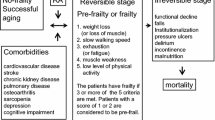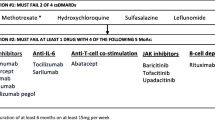Abstract
Rheumatoid arthritis (RA) is associated with progressive joint destruction, with functional status influenced by both disease activity and radiographic progression. The case for early aggressive treatment of RA is based on large amounts of good data in many countries. Studies with conventional disease-modifying anti-rheumatic drugs in early RA have shown improved outcomes compared with later treatment, especially if an aggressive approach with combinations of drugs is used. Early intervention with tumour necrosis factor (TNF) inhibitors has been shown to improve clinical outcomes, induce remission and prevent radiographic progression. It also improves patients’ functional status, health-related quality of life, and reduces fatigue. Patients with RA have reduced productivity, an increased number of lost work days and retire early; enabling patients to work should be at the core of a therapy’s cost-effectiveness. Introduction of anti-TNF therapy early in RA has been shown to decrease job loss and reduce the amount of working time missed. Although the drug costs of initial treatment with combination therapy including a TNF inhibitor are high, these may be compensated by the reduction in lost productivity, making such a strategy cost-effective overall. In addition, some patients who respond well to combination therapy may be able to stop the TNF inhibitor. It is important to assess the benefits of any intervention not just to healthcare costs but to society as a whole, and physicians should be advocates for optimal access to effective therapies for their patients.




Similar content being viewed by others
References
Drossaers-Bakker KW, de Buck M, van Zeben D, Zwinderman AH, Breedveld FC, Hazes JM (1999) Long-term course and outcome of functional capacity in rheumatoid arthritis: the effect of disease activity and radiologic damage over time. Arthritis Rheum 42:1854–1860
van Aken J, Lard LR, le Cessie S, Hazes JM, Breedveld FC, Huizinga TW (2004) Radiological outcome after 4 years of early vs delayed treatment strategy in patients with recent onset rheumatoid arthritis. Ann Rheum Dis 63:274–279
Cush JJ (2007) Early rheumatoid arthritis—is there a window of opportunity? J Rheumatol Suppl 80:1–7
Benhamou M, Rincheval N, Roy C, Foltz V, Rozenberg S, Sibilia J et al (2009) The gap between practice and guidelines in the choice of first-line disease modifying antirheumatic drug in early rheumatoid arthritis: results from the ESPOIR cohort. J Rheumatol 36:934–942
Emery P, McInnes IB, van Vollenhoven R, Kraan MC (2008) Clinical identification and treatment of a rapidly progressing disease state in patients with rheumatoid arthritis. Rheumatology 47:392–398
Emery P (2002) Magnetic resonance imaging: opportunities for rheumatoid arthritis disease assessment and monitoring long-term treatment outcomes. Arthritis Res 4(Suppl 2):S6–S10
Anderson JJ, Wells G, Verhoeven AC, Felson DT (2000) Factors predicting response to treatment in rheumatoid arthritis: the importance of disease duration. Arthritis Rheum 43:22–29
Möttönen T, Hannonen P, Korpela M, Nissilä M, Kautiainen H, Ilonen J et al (2002) Delay to institution of therapy and induction of remission using single-drug or combination-disease-modifying antirheumatic drug therapy in early rheumatoid arthritis. Arthritis Rheum 46:894–898
Aletaha D, Smolen J, Ward MM (2006) Measuring function in rheumatoid arthritis: identifying reversible and irreversible components. Arthritis Rheum 54:2784–2792
Green M, Marzo-Ortega H, McGonagle D, Wakefield R, Proudman S, Conaghan P, Gooi J, Emery P (1999) Persistence of mild, early inflammatory arthritis: the importance of disease duration, rheumatoid factor, and the shared epitope. Arthritis Rheum 42:2184–2188
Finckh A, Liang MH, van Herckenrode CM, de Pablo P (2006) Long-term impact of early treatment on radiographic progression in rheumatoid arthritis: a meta-analysis. Arthritis Rheum 55:864–872
Mottonen T, Hannonen P, Leirisalo-Repo M, Nissila M, Kautiainen H, Korpela M et al (1999) Comparison of combination therapy with single-drug therapy in early rheumatoid arthritis: a randomized trial. Lancet 353:1568–1573
Korpela M, Laasonen L, Hannonen P, Kautiainen H, Leirisalo-Repo M, Hakala M et al (2004) Retardation of joint damage in patients with early rheumatoid arthritis by initial aggressive treatment with disease-modifying antirheumatic drugs: five-year experience from the FIN-RACo study. Arthritis Rheum 50:2072–2081
Brown AK, Conaghan PG, Karim Z, Quinn MA, Ikeda K, Peterfy CG et al (2008) An explanation for the apparent dissociation between clinical remission and continued structural deterioration in rheumatoid arthritis. Arthritis Rheum 58:2958–2967
Emery P, Breedveld FC, Hall S, Durez P, Chang DJ, Robertson D, Singh A, Pedersen RD, Koenig AS, Freundlich B (2008) Comparison of methotrexate monotherapy with a combination of methotrexate and etanercept in active, early, moderate-to-severe rheumatoid arthritis (COMET): a randomised, double-blind, parallel treatment trial. Lancet 372:375–382
Genovese MC, Bathon JM, Martin RW, Fleischmann RM, Tesser JR, Schiff MH et al (2002) Etanercept vs methotrexate in patients with early rheumatoid arthritis: two-year radiographic and clinical outcomes. Arthritis Rheum 46:1443–1450
Breedveld FC, Weisman MH, Kavanaugh AF, Cohen SB, Pavelka K, van Vollenhoven R et al (2006) The PREMIER study: a multicenter, randomized, double-blind clinical trial of combination therapy with adalimumab plus methotrexate vs methotrexate alone or adalimumab alone in patients with early, aggressive rheumatoid arthritis who had not had previous methotrexate treatment. Arthritis Rheum 54:26–37
Emery P, Genovese MC, van Vollenhoven R, Sharp JT, Patra K, Sasso EH (2009) Less radiographic progression with adalimumab plus methotrexate vs methotrexate monotherapy across the spectrum of clinical response in early rheumatoid arthritis. J Rheumatol 36:1429–1441
Allaart CF, Goekoop-Ruiterman YP, de Vries-Bouwstra JK, Breedveld FC, Dijkmans BA, FARR Study Group (2006) Aiming at low disease activity in rheumatoid arthritis with initial combination therapy or initial monotherapy strategies: the BeSt study. Clin Exp Rheumatol 24(6 Suppl 43):S-77–S-82
Kekow J, Moots RJ, Emery P, Durez P, Koenig A, Singh A et al (2010) Patient-reported outcomes improve with etanercept plus methotrexate in active early rheumatoid arthritis and the improvement is strongly associated with remission: the COMET trial. Ann Rheum Dis 69:222–225
Yount S, Sorensen MV, Cella D, Sengupta N, Grober J, Chartash EK (2007) Adalimumab plus methotrexate or standard therapy is more effective than methotrexate or standard therapies alone in the treatment of fatigue in patients with active, inadequately treated rheumatoid arthritis. Clin Exp Rheumatol 25:838–846
Kimel M, Cifaldi M, Chen N, Revicki D (2008) Adalimumab plus methotrexate improved SF-36 scores and reduced the effect of rheumatoid arthritis (RA) on work activity for patients with early RA. J Rheumatol 35:206–215
National Institute for Health and Clinical Excellence (2007) Adalimumab, etanercept and infliximab for the treatment of rheumatoid arthritis. NICE, London
Burton W, Morrison A, Maclean R, Ruderman E (2006) Systematic review of studies of productivity loss due to rheumatoid arthritis. Occup Med (Lond) 56:18–27
Puolakka K, Kautiainen H, Pekurinen M, Möttönen T, Hannonen P, Korpela M et al (2006) Monetary value of lost productivity over a five year follow up in early rheumatoid arthritis estimated on the basis of official register data on patients’ sickness absence and gross income: experience from the FIN-RACo trial. Ann Rheum Dis 65:899–904
Lacaille D (2005) Arthritis and employment research: where are we? Where do we need to go? J Rheumatol Suppl 72:42–45
Puolakka K, Kautiainen H, Möttönen T, Hannonen P, Korpela M, Hakala M et al (2005) Early suppression of disease activity is essential for maintenance of work capacity in patients with recent-onset rheumatoid arthritis: five-year experience from the FIN-RACo trial. Arthritis Rheum 52:36–41
Eberhardt K, Larsson BM, Nived K, Lindqvist E (2007) Work disability in rheumatoid arthritis—development over 15 years and evaluation of predictive factors over time. J Rheumatol 34:481–487
Bejarano V, Quinn M, Conaghan PG, Reece R, Keenan AM, Walker D et al (2008) Effect of the early use of the anti-tumor necrosis factor adalimumab on the prevention of job loss in patients with early rheumatoid arthritis. Arthritis Rheum 59:1467–1474
Mazonson P, Globe D, Santas C, Murphy R, Cheng A, Huang X et al (2008) Assessing the impact of etanercept treatment on productivity: results from a recent RA patient work loss and productivity survey. Ann Rheum Dis 67(Suppl II):646
Anis A, Zhang W, Emery P, Sun H, Singh A, Freundlich B, Sato R (2009) The effect of etanercept on work productivity in patients with early active rheumatoid arthritis: results from the COMET study. Rheumatology 48:1283–1289
Augustsson J, Neovius M, Cullinane-Carli C, Eksborg S, van Vollenhoven RF (2010) Patients with rheumatoid arthritis treated with tumour necrosis factor antagonists increase their participation in the workforce: potential for significant long-term indirect cost gains (data from a population-based registry). Ann Rheum Dis 69:126–131
Tanaka Y, Takeuchi T, Mimori T, Miyasaka N, Koike T (2009) Discontinuation of infliximab therapy is possible after acquiring remission in patients with rheumatoid arthritis (RA): first report on RRR (remission induction by remicade in RA) study. Ann Rheum Dis 68(Suppl 3):120
Saleem B, Nizam S, Emery P (2006) Can remission be maintained with or without further drug therapy in rheumatoid arthritis? Clin Exp Rheumatol 24(Suppl 43):S-33–S-36
Fautrel B, Pham T, Mouterde G, Le Loët X, Goupille P, Guillemin F et al (2007) Recommendations of the French Society for Rheumatology regarding TNFalpha antagonist therapy in patients with rheumatoid arthritis. Joint Bone Spine 74:627–637
van den Hout WB, Goekoop-Ruiterman YP, Allaart CF, de Vries-Bouwstra JK, Hazes JM, Kerstens PJ et al (2009) Cost-utility analysis of treatment strategies in patients with recent-onset rheumatoid arthritis. Arthritis Rheum 61:291–299
Conflict of interest
The content of this article is the sole responsibility of the author. Medical writing assistance for the preparation of this article was provided by Synergy who received financial support from Pfizer. F. Breedveld has received honoraria from Abbott and Pfizer for speaking and consulting.
Author information
Authors and Affiliations
Corresponding author
Rights and permissions
About this article
Cite this article
Breedveld, F. The value of early intervention in RA—a window of opportunity. Clin Rheumatol 30 (Suppl 1), 33–39 (2011). https://doi.org/10.1007/s10067-010-1638-5
Received:
Accepted:
Published:
Issue Date:
DOI: https://doi.org/10.1007/s10067-010-1638-5




